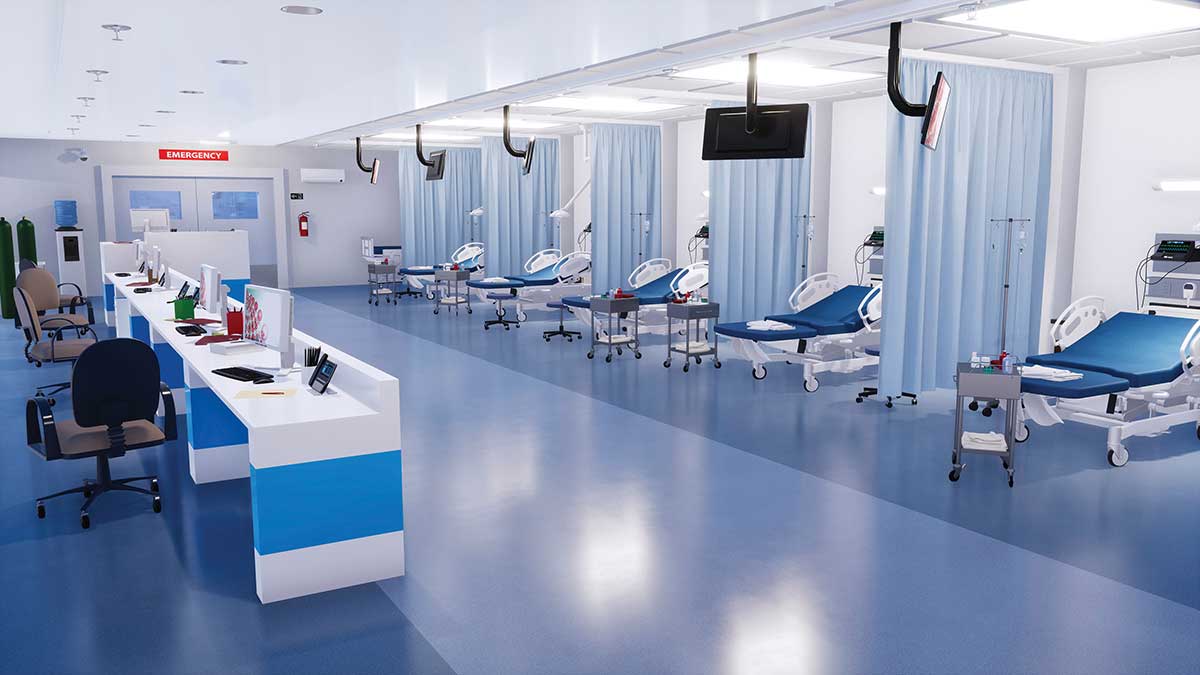NEC Article 517, Health Care Facilities
Article 517 of the 2020 National Electrical Code (NEC) covers requirements for the construction and installation of electrical equipment in health care facilities.
Health care facilities are defined in 517.2 as “buildings, portions of buildings, or mobile enclosures in which human, medical, dental, psychiatric, nursing, obstetrical, or surgical care is provided [99:3.3.71].
Part I covers general requirements such as the scope and definitions that apply to these facilities.
Requirements of Parts II and III apply to multifunction facilities with respect to patient care areas and rooms with those types of occupancies.
Also, Chapters 5, 6, and 7 may supplement or modify the requirements in Chapters 1 through 7.
Types Of Health Care Facilities
When most people think of health care facilities, they think of hospitals or emergency care units. However, the informational note in the NEC 517.2 definition of Health Care Facilities also includes, but not limited to:
- hospitals
- nursing homes
- limited care facilities,
- clinics,
- medical and dental offices,
- and ambulatory care centers.
Article 517 applies to electrical construction and installation criteria in health care facilities that provide services to human beings.
It is not intended to be applicable to veterinary care facilities or clinics used for medical treatment for animals.
Patient Care Vicinity
Article 517.2 defines patient care vicinity as a space intended for the examination and treatment of patients that extends 1.8 m (6 ft) beyond the normal location of the bed, chair, or other device that supports the patient during examination and treatment and extending vertically to 2.3 m (7 ft 6 in.) above the floor (see figure 1).

Part II Wiring And Protection
Part II of Article 517 applies to all patient care spaces within health care facilities. Part II is required to apply to areas where patients are intended to be placed on life support systems or subjected to invasive procedures and connected to line-operated electromedical devices within these limited care facilities.
It does not apply to business offices, corridors, waiting rooms, and the like in clinics, medical and dental offices, outpatient facilities, or areas used exclusively for immunizations, psychiatry and psychotherapy, alternative medicine or optometry.
Wiring methods for health care facilities are required to comply with the applicable provisions of Chapters 1 through 4 except as modified, supplemented, or amended by Article 517. See also 90.3, Code Arrangement.
90.3 Application Example
In Article 517, the equipment grounding conductor requirements for branch circuits serving patient care locations is amended to be more restrictive. Two equipment grounding (protective bonding) paths are the goal and rule.
Section 517.13(A) modifies the general requirements in Article 250 by requiring an insulated, copper equipment grounding conductor and installing this conductor in a metal raceway that qualifies as an equipment grounding return path in accordance with Section 250.118.
The amendments/modifications are as follows:
- Insulated, copper equipment grounding conductors
- Installed in metal raceways that are identified equipment grounding conductor return paths.
These are two more restrictive requirements than what is normally acceptable in Section 250.118.
Part III Essential Electrical Systems
Part III covers essential electrical systems as noted in Section 517.25. The section mandates that Type 1 and Type 2 essential electrical services (ESS) for healthcare facilities shall comprise separate branches capable of supplying a limited amount of lighting and power service, considered essential for the life safety and orderly cessation of procedures during the time normal electrical service is interrupted. Additional information can be found in NFPA 99-2018, Health Care Facilities.
Part IV Inhalation Anesthetizing Location Classification
Part IV applies to locations where flammable anesthetics are employed. If either of the anesthetizing locations in 517.60(A) or (B) is considered a wet procedure location, refer to 517.20. Safeguarding information can be found in NFPA 99.
Part V X-Ray Applications
Part V applies to the use of X-ray installations. Nothing in this part of the Code should be construed as specifying safeguards against the useful beam or stray X-ray radiation. Radiation safety and performance requirements are enforced by the Department of Health and Human Services and are regulated under Public Law 90-602.
Part VI Communications, Signaling Systems, Data Systems, Fire Alarm Systems, And Systems Less Than 120 Volts, Nominal
In patient care spaces, 517.80 requires that equivalent insulation and isolation to that required for the electrical distribution systems shall be provided for communications, signaling systems, data system circuits, fire alarm systems, and systems less than 120 volts, nominal. Class 2 and Class 3 systems are not required to comply with the grounding requirements of 517.13, to comply with the mechanical protection requirements of 517.31(C)(3)(5), or to be enclosed in raceways unless otherwise specified by Chapter 7 or 8.
Part VII Isolated Power Systems
Part VII of Article 517 covers the installation requirements for isolated power systems in health care facilities. These systems are an optional protection technique that can be used for certain patient care areas of health care facilities as provided in 517.19(E). Isolated power systems are required to be used where interruption by a GFCI under fault conditions cannot be tolerated as required by 517.20(A).
Each circuit shall be controlled by a switch that has a disconnecting pole in each conductor that will disconnect all power simultaneously. Isolation shall be accomplished by use of isolation transformer(s) having no direct electrical connection between primary and secondary windings. Motor generators and batteries are permitted. Secondary of isolated power system is not permitted to be grounded. 250.22(2), 517.160(A)(2).
Codes That Apply To Health Care Facilities
The following standards apply to the protection of electrical equipment and services within these facilities.
- Automatic Sprinklers, NFPA 13
- Fire Pumps, NFPA 20
- National Electrical Code (NEC), NFPA 70
- Electrical Workplace Safety, NFPA 70E
- National Fire Alarm Code, NFPA 72
- Garages and Parking Structures, NFPA 88A
- Health Care Facilities, NFPA 99
- Life Safety Code, NFPA 101
- Emergency and Standby Power, NFPA 110
- Lightning Protection Code, NFPA 780
- Other Model Building Codes, ICC – IBC
Summary
Health care facilities are special occupancies falling under the requirements of Chapter 5 of the NEC titled “Special Occupancies.” The requirements of Chapters 1 through 4 of the Code are applicable and are modified to be more restrictive in many areas.
Redundancy of power systems, circuits, grounding, and bonding all are directed toward continuity of power and service for patient care. Careful planning, design, engineering, installation, and inspection are critical for health care facility electrical system installations.















Find Us on Socials